
In modern rubber manufacturing, the choice of the right rubber accelerator plays a crucial role in achieving performance, safety, and compliance. Among the most widely used are TMTD (Tetramethylthiuram Disulfide), ZDBC (Zinc Dibutyldithiocarbamate), and ZDEC (Zinc Diethyldithiocarbamate) — each offering unique curing characteristics and benefits. With growing regulatory pressure against nitrosamine-forming accelerators like TMTD, industries are now exploring ZDBC and ZDEC as safer, more efficient replacements.
This article provides an in-depth technical comparison between these accelerators, highlighting their chemical properties, curing behavior, industrial applications, performance differences, advantages, and testing procedures. Whether you’re a rubber compounder, latex glove manufacturer, or industrial technologist, this comprehensive guide helps you understand how to replace TMTD with ZDBC or ZDEC successfully while maintaining product quality, compliance, and performance.
Introduction to Rubber Accelerators
To understand the feasibility of replacing TMTD with ZDBC or ZDEC, it’s essential first to recognize the main families of rubber accelerators. These chemicals influence the vulcanization rate, scorch safety, and mechanical properties of rubber products. The following table outlines key accelerator types, their short forms, chemical families, and industrial uses to give a clear overview of their distinct functions within rubber compounding.
| Accelerator Type | Abbreviation | Chemical Family | Key Function | Used In |
|---|---|---|---|---|
| Mercaptobenzothiazole | MBT | Thiazole | Primary accelerator | General rubber goods |
| Dibenzothiazyl Disulfide | MBTS | Thiazole disulfide | Secondary, delayed action | Tyres, belts |
| Tetramethylthiuram Disulfide | TMTD | Thiuram | Ultra accelerator, sulfur donor | Cables, latex, seals |
| Zinc Dibutyldithiocarbamate | ZDBC | Dithiocarbamate | Ultra accelerator, non-sulfur donor | Latex, footwear, medical products |
| Zinc Diethyldithiocarbamate | ZDEC | Dithiocarbamate | Ultra accelerator, fast-curing | Latex, surgical gloves, balloons |
What Is TMTD?
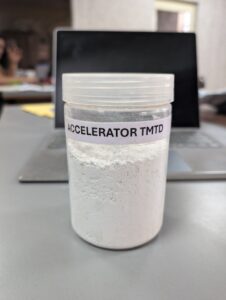
Before we talk about replacing TMTD, we must understand what makes it such a popular choice. TMTD is one of the most commonly used thiuram-based ultra accelerators, known for its fast curing speed and sulfur-donor ability. However, due to nitrosamine generation, industries are now seeking alternatives. The table below explains the chemical nature, structure, applications, and limitations of TMTD in industrial rubber formulations.
| Parameter | Details |
|---|---|
| Full Chemical Name | Tetramethylthiuram Disulfide |
| Formula | C₆H₁₂N₂S₄ |
| Type | Thiuram Accelerator (Ultra) |
| Function | Acts as an ultra-fast accelerator and partial sulfur donor |
| Common Application | Tyre compounds, rubber hoses, insulation, molded goods |
| Advantages | High activity, short cure time, sulfur-free curing possible |
| Limitations | Can cause bloom, low scorch safety, nitrosamine formation risk |
Problem Identified:
TMTD generates nitrosamines during processing — substances of environmental and health concern, now regulated globally (EU, REACH, EPA).
Why Consider Replacing TMTD with ZDBC or ZDEC?
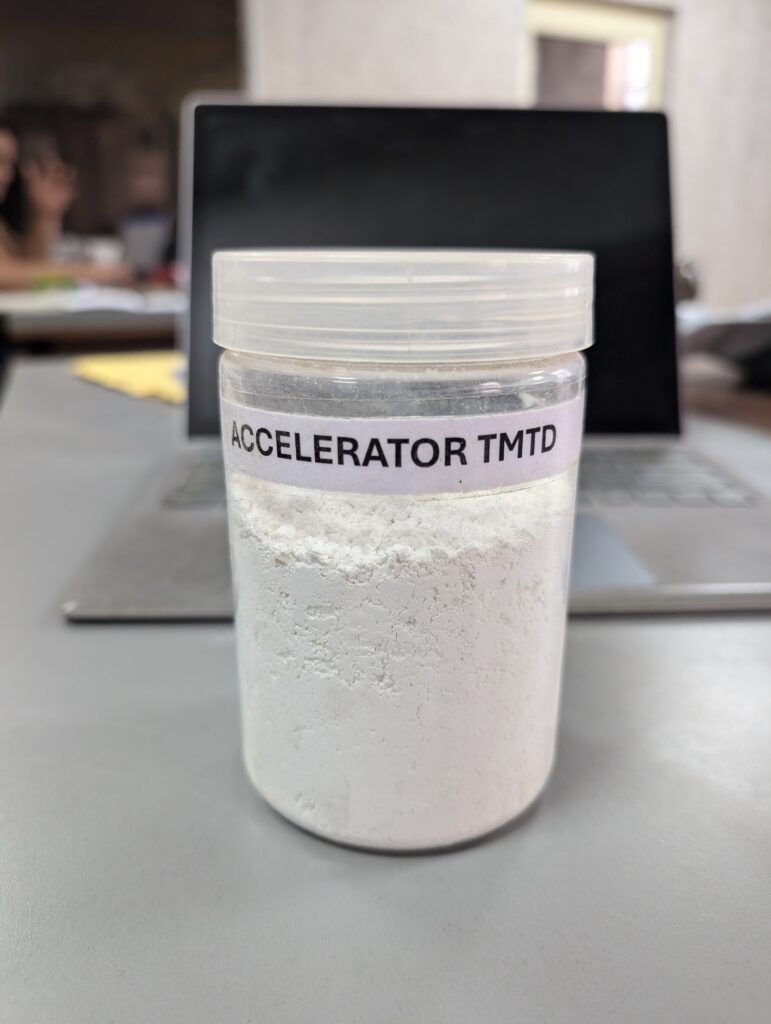
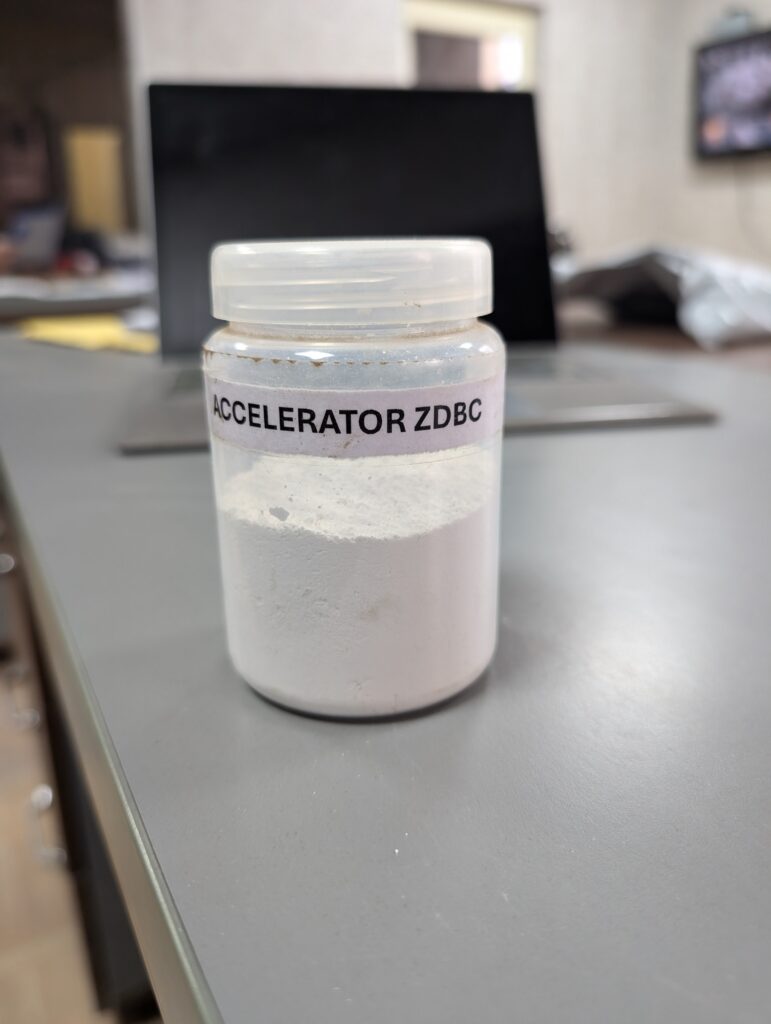
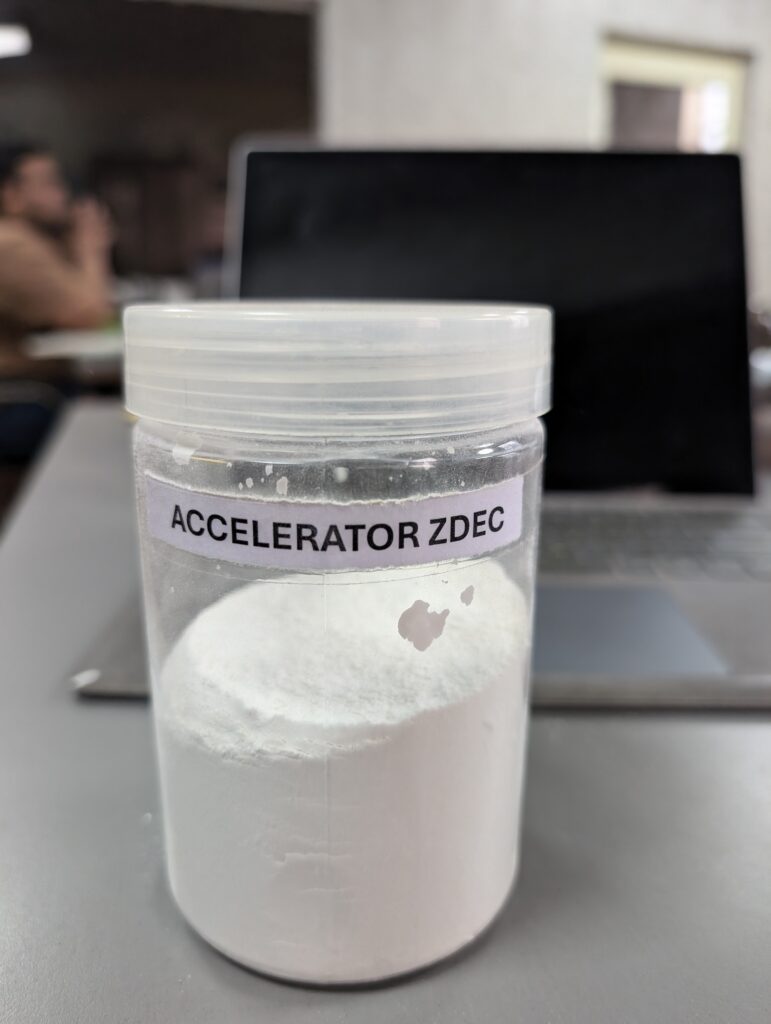
Now that we know the fundamentals of TMTD, let’s look at why manufacturers are replacing it with ZDBC and ZDEC. These alternatives belong to the dithiocarbamate family and provide excellent curing efficiency with much safer profiles. The next table compares TMTD, ZDBC, and ZDEC side-by-side, analyzing critical aspects such as cure speed, scorch safety, toxicity, sulfur-donor capability, and application areas.
Replacement Goal:
To maintain curing performance while reducing nitrosamine formation and improving safety compliance.
| Feature | TMTD | ZDBC | ZDEC |
|---|---|---|---|
| Chemical Family | Thiuram | Dithiocarbamate | Dithiocarbamate |
| Nitrosamine Formation | Yes (NDMA risk) | Low | Low |
| Sulfur Donor Capability | Yes | No | No |
| Cure Speed | Very Fast | Fast | Ultra Fast |
| Scorch Safety | Low | Moderate | Moderate |
| Use in Latex | Limited | Excellent | Excellent |
| Toxicity Level | Moderate | Low | Low |
| Blooming Risk | Possible | Low | Low |
| Best Suitable For | Solid rubber | Latex, gloves | Latex, soft products |
Replacement Compatibility and Formulation Adjustments
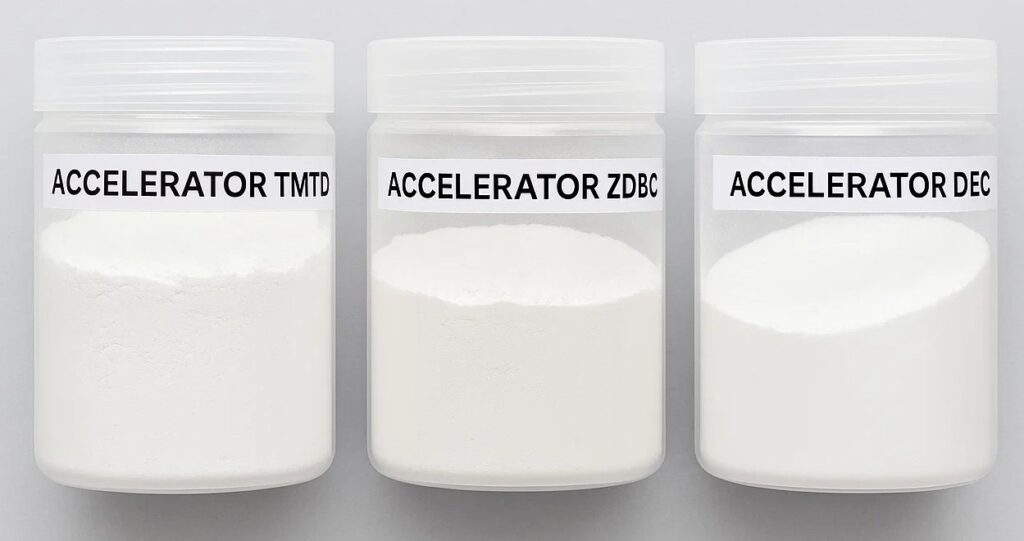
Simply substituting TMTD with ZDBC or ZDEC isn’t a one-step process — formulation adjustments are necessary to maintain optimal cure characteristics and mechanical strength. Adjustments to sulfur levels, cure temperature, and accelerator ratios help achieve desired results. The following table outlines each key modification required when replacing TMTD, along with the reasons behind these adjustments.
To replace TMTD with ZDBC or ZDEC, several formulation and curing adjustments must be made:
| Step | Adjustment Needed | Reason |
|---|---|---|
| 1 | Increase sulfur content by 0.1–0.2 phr | Because ZDBC/ZDEC are not sulfur donors |
| 2 | Combine with secondary accelerator (like MBTS or CBS) | To improve cure rate and scorch safety |
| 3 | Optimize temperature (lower by 5–10°C) | Dithiocarbamates cure faster |
| 4 | Conduct rheometer and reversion tests | To ensure equivalent modulus and cure curve |
| 5 | Add antioxidant (like TMQ) | To maintain aging resistance |
Laboratory Testing Methods
Proper laboratory testing ensures the new accelerator system matches the performance of the traditional TMTD-based compound. Key tests such as rheometer analysis, tensile strength evaluation, and nitrosamine detection help validate replacement quality. The table below lists the most important lab tests, their purposes, the equipment used, and what results to expect when evaluating ZDBC/ZDEC as replacements.
| Test Name | Purpose | Equipment Used | Expected Result |
|---|---|---|---|
| Rheometer Test (ODR/MDR) | Check cure curve (Tc90, Scorch time) | Moving Die Rheometer | Equivalent or faster cure |
| Tensile Strength Test | Measure physical properties | UTM | ≥ TMTD control sample |
| Aging Test | Evaluate stability | Hot air oven | No degradation or hardening |
| Nitrosamine Analysis (GC/MS) | Check safety compliance | Gas Chromatography | NDMA < Regulatory limit |
| Blooming Observation | Surface quality test | Visual or microscope | No white powder on surface |
Real-World Examples for You
Numerous manufacturers have successfully implemented TMTD-free formulations using ZDBC and ZDEC in different rubber sectors. From latex gloves to industrial rubber sheets, the performance remains consistent while achieving regulatory compliance. The next table provides real-world case examples demonstrating the effectiveness of these replacements across various products and applications.
| Product Type | Traditional Accelerator | Replacement Accelerator | Result |
|---|---|---|---|
| Surgical Gloves | TMTD | ZDEC | Improved safety, faster cure |
| Latex Balloons | TMTD | ZDBC | Better color, no blooming |
| Rubber Gaskets | TMTD + MBTS | ZDEC + CBS | Equal strength, safer curing |
| Rubber Sheets | TMTD | ZDBC | Good elasticity, non-toxic |
| Shoe Soles | TMTD | ZDEC | Odorless, stable production |
Key Benefits of Using ZDBC / ZDEC Instead of TMTD
ZDBC and ZDEC are not just replacements but improvements in many respects. They offer better environmental safety, improved scorch control, and stable curing while delivering consistent mechanical properties. The following table highlights the major benefits that make ZDBC and ZDEC superior alternatives to TMTD in today’s modern rubber formulations.
| Benefit | Description |
|---|---|
| Environmentally Safer | No harmful nitrosamine formation |
| Regulatory Compliance | Accepted under REACH and FDA latex norms |
| Better Scorch Control | More process-safe for latex dipping |
| Improved Appearance | Reduced blooming and odor |
| Versatile Use | Suitable for both latex and dry rubber |
| Lower Cost in Long Term | Due to stable performance and fewer rejects |
Common Problems During Replacement and Solutions
While transitioning to new accelerators, certain processing or performance challenges may occur. These problems are generally easy to fix with the right formulation and control measures. The table below presents common issues faced during TMTD replacement and the recommended technical solutions to maintain stability, cure performance, and quality.
| Problem | Possible Cause | Solution |
|---|---|---|
| Slower Cure Rate | Missing sulfur donor effect of TMTD | Add 0.2 phr extra sulfur or use CBS as booster |
| Low Modulus | Insufficient cross-link density | Adjust ZnO or stearic acid levels |
| Poor Aging Resistance | Overcuring at high temperature | Optimize cure time and add antioxidant |
| Scorching in Latex Compounds | High accelerator loading | Reduce phr by 0.1–0.2 and lower temp |
| Color Change / Odor | Impure ZDBC/ZDEC grades | Use high-purity grades from reliable source |
Industrial and Commercial Uses
Every accelerator type finds its strength in specific product categories. From medical latex gloves to automotive rubber parts, ZDBC and ZDEC are now widely adopted. The table below summarizes industrial and commercial applications for each accelerator, helping manufacturers identify the most suitable options for their production lines.
| Product | Recommended Accelerator | Remarks |
|---|---|---|
| Latex Gloves | ZDEC | Medical-grade approved |
| Balloons | ZDBC | Good elongation and film strength |
| Rubber Bands | ZDBC + ZMBT | Balanced cure and tensile |
| Footwear | ZDEC | Smooth surface, durable |
| Automotive Rubber Parts | ZDBC + CBS | Heat resistant |
| Seals and Gaskets | ZDEC | Flexibility retained |
| Conveyor Belts | ZDEC + MBTS | Reinforced cure |
Chemical Comparison Summary Table
Chemical properties such as molecular weight, melting point, and appearance influence how an accelerator behaves during compounding. This next table provides a side-by-side chemical comparison of TMTD, ZDBC, and ZDEC, offering valuable data for compounders optimizing their formulations.
| Property | TMTD | ZDBC | ZDEC |
|---|---|---|---|
| CAS No. | 137-26-8 | 136-23-2 | 14324-55-1 |
| Molecular Weight | 240.44 | 474.92 | 431.87 |
| Solubility | Insoluble in water | Insoluble | Insoluble |
| Appearance | White to pale yellow powder | White powder | White powder |
| Melting Point | 155°C | 104°C | 175°C |
| Storage Stability | Good | Very good | Excellent |
Replacement Testing Procedure (Step-by-Step)
For practical implementation, it’s essential to follow a systematic lab-to-production testing procedure. This ensures that replacement accelerators like ZDBC or ZDEC meet performance standards before industrial rollout. The following table explains the step-by-step testing process, from control mixing to rheometer analysis and final approval.
| Step | Procedure | Purpose |
|---|---|---|
| 1 | Prepare control mix with TMTD | Establish baseline cure data |
| 2 | Replace with ZDEC (same phr) | Observe initial difference |
| 3 | Adjust sulfur and retest | Optimize cure characteristics |
| 4 | Rheometer test for Tc90 | Confirm cure efficiency |
| 5 | Mold and cure samples | Physical testing |
| 6 | Compare tensile, elongation | Verify equivalency |
| 7 | Check for bloom, reversion | Quality assurance |
| 8 | Record final formulation | Approve industrial use |
Industrial Insight
With sustainability becoming a priority, many industries have already transitioned toward safer accelerators. The insights below reflect how rubber manufacturers across Asia and Europe are adopting ZDBC/ZDEC-based curing systems to replace TMTD while maintaining productivity and compliance.
Many rubber compounders in India, Malaysia, and Thailand have successfully phased out TMTD in favor of ZDBC or ZDEC to comply with EU REACH Annex XVII and automotive OEM environmental standards.
This shift is part of the “Green Rubber Processing Movement”, emphasizing non-toxic, eco-friendly curing systems.
Key Points to Remember
To summarize the key technical takeaways, the table below highlights the most important factors to remember when substituting TMTD with ZDBC or ZDEC. These points cover sulfur balance, test requirements, and formulation control tips that help ensure smooth replacement and product quality.
- ZDBC and ZDEC are excellent low-toxicity alternatives to TMTD.
- Adjust sulfur level and accelerator ratios carefully during replacement.
- Always conduct lab rheometer testing before scaling up.
- Use high-purity, low-nitrosamine grades for latex and medical rubber.
- Proper compounding ensures equal or better mechanical properties than TMTD systems.
Buy High-Quality Rubber Accelerators & Chemicals from ARPL
At Arihant Reclamation Pvt. Ltd. (ARPL), we take pride in being one of India’s most trusted manufacturers and exporters of rubber accelerators, antioxidants, and zinc oxide. Our products are designed for consistent quality, high performance, and reliable processing in tyre and non-tyre applications. Whether you require ZDBC, ZDEC, or other TMTD replacement accelerators, our formulations ensure superior vulcanization, long-lasting durability, and eco-friendly compliance.
With a fully equipped manufacturing facility, advanced testing laboratories, and experienced chemical engineers, ARPL guarantees precision and uniformity in every batch we produce. We serve a wide range of industries — from automotive rubber parts and industrial seals to latex gloves, footwear, and conveyor belts — delivering results that meet both domestic and international quality standards.
We offer bulk supplies, customized chemical solutions, and Pan-India delivery, ensuring quick turnaround times and dependable support for all clients. Our goal is to build long-term partnerships by providing not just quality materials but also expert guidance and technical support for optimizing your production efficiency.
If you are looking for reliable rubber chemical suppliers in India or planning to switch to safer TMTD-free alternatives, ARPL is your best choice for innovation, sustainability, and affordability.
| Product | Typical Use Cases |
|---|---|
| Accelerator MBT | General rubber goods, footwear soles, hoses |
| Accelerator MBTS | Tires, conveyor belts, thick molded products |
| Accelerator CBS | Fast curing for automotive rubber, mechanical goods |
| Accelerator TMTD | As ultra accelerator or sulfur donor in rubber blends |
| Accelerator ZDEC | Ultra-fast latex applications like gloves & balloons |
| Antioxidant IPPD | Protects rubber from oxygen & flex cracking |
| Antioxidant 6PPD | Outstanding ozone & weather resistance for outdoor rubber |
Why ARPL is the Right Choice
- 🏆 Recognized Exporter & Supplier
- 🧪 ISO-certified production with strict quality control
- 🚚 Fast logistics network to all major cities
- 📈 Flexible MOQ & bulk order fulfillment
✅ Connect With Us Today!
📞 Phone: +91-8860732624
📧 Email: arihantreclamation@gmail.com
🌐 Website: www.arihantreclamationpvtltd.com